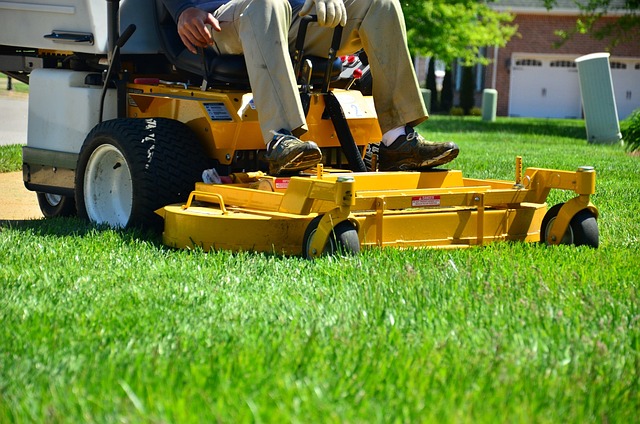Mulching is a Lawn Care and Landscaping practice that improves grass health and aesthetics by retaining soil moisture, suppressing weeds, and regulating temperature. It reduces watering needs, protects roots from extreme temperatures, and promotes lush growth. Organic mulches enhance soil fertility while inorganic options offer durability and low maintenance. The choice depends on texture, color, budget, and lawn conditions, with organic mulches favored for environmental benefits but requiring more frequent replacement, while inorganic mulches have lower upkeep but less impact on soil health. Lawn Care and Landscaping professionals use precision edging to maintain clean lines along lawn edges.
Transform your lawn into a vibrant, healthy oasis with the power of mulching and edging. This comprehensive guide delves into the essential practices of lawn care and landscaping, showcasing how these techniques contribute to a lush, well-maintained space. Understanding mulching—its benefits, types, and impact on soil health—is key. Edging, too, plays an integral role in enhancing aesthetics and durability. Combining these practices creates a step-by-step blueprint for optimal lawn care, ensuring your outdoor space not only looks pristine but thrives.
- Understanding Mulching: Benefits and Types for Lawn Health
- – Explanation of mulching and its advantages for lawns
- – Different types of mulch and their unique properties
Understanding Mulching: Benefits and Types for Lawn Health

Mulching is an essential practice in lawn care and landscaping, offering numerous benefits for grass health and overall yard aesthetics. It involves applying a layer of organic or inorganic material over the soil to retain moisture, suppress weeds, and regulate soil temperature. This simple yet powerful technique plays a crucial role in maintaining a lush and vibrant lawn. By preventing weed growth, mulch acts as a natural barrier, reducing the need for chemical herbicides, which can be harmful to the environment and beneficial insects.
There are various types of mulch available, each with unique advantages. Organic mulches, such as wood chips, straw, or compost, enrich the soil over time by decomposing, providing essential nutrients. Inorganic options like stones, gravel, or rubber chips offer long-lasting solutions, ideal for paths and areas requiring minimal maintenance. For lawn edges, precision edging with tools or electric edgers creates clean lines, enhancing the overall look. Incorporating mulching into your lawn care routine is a game-changer, ensuring a healthier, more visually appealing outdoor space.
– Explanation of mulching and its advantages for lawns

Mulching is a lawn care practice that involves applying organic material, like wood chips or straw, to the soil surface around and between grass plants. It’s an effective landscaping strategy for maintaining a healthy, vibrant lawn while offering numerous advantages. One of the key benefits is moisture retention; mulched areas tend to stay wetter for longer periods, reducing the need for frequent watering, which is particularly advantageous in regions with water scarcity or during hot summers.
Additionally, organic mulch acts as a natural insulator, protecting the soil and roots from extreme temperatures, fostering a more consistent microclimate. This insulation helps prevent winter damage and promotes quicker grass growth in spring. Mulching also suppresses weeds effectively, blocking sunlight that would otherwise enable weed seeds to germinate. By reducing weed competition, mulched lawns require less intensive lawn care and landscaping, saving time and resources for homeowners, while contributing to a more sustainable approach to lawn maintenance and overall landscaping practices.
– Different types of mulch and their unique properties

Mulch, an essential component of effective lawn care and landscaping, comes in various types, each with distinct characteristics that cater to specific needs. Organic mulches, derived from natural materials like wood chips, straw, or compost, not only enhance soil fertility but also improve water retention and suppress weeds naturally. Inorganic alternatives, such as stones, gravel, or rubber, offer prolonged durability, making them ideal for high-traffic areas. They also provide a consistent, low-maintenance aesthetic appeal.
The choice of mulch depends on factors like desired texture, color, budget, and lawn conditions. For instance, wood chips are popular for their ability to break down slowly, while stones provide quick ground cover. Landscapers often prefer organic mulches for their environmental benefits but must account for potential nutrient leaching over time. Conversely, inorganic mulches require less frequent replacement but may not contribute as significantly to soil health and biodiversity as their organic counterparts do in lawn care and landscaping practices.
Mulching and edging are essential practices in lawn care and landscaping, offering numerous benefits for your grass’s health and overall aesthetics. By incorporating various types of mulch, you can enhance soil fertility, retain moisture, suppress weeds, and improve the overall appearance of your lawn. Edging, meanwhile, ensures clean lines and a polished look, defining the boundaries between your lawn and paths or driveways. Combining these techniques creates a vibrant, well-maintained landscape that enhances your outdoor living spaces.
